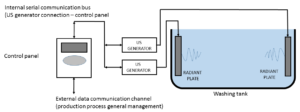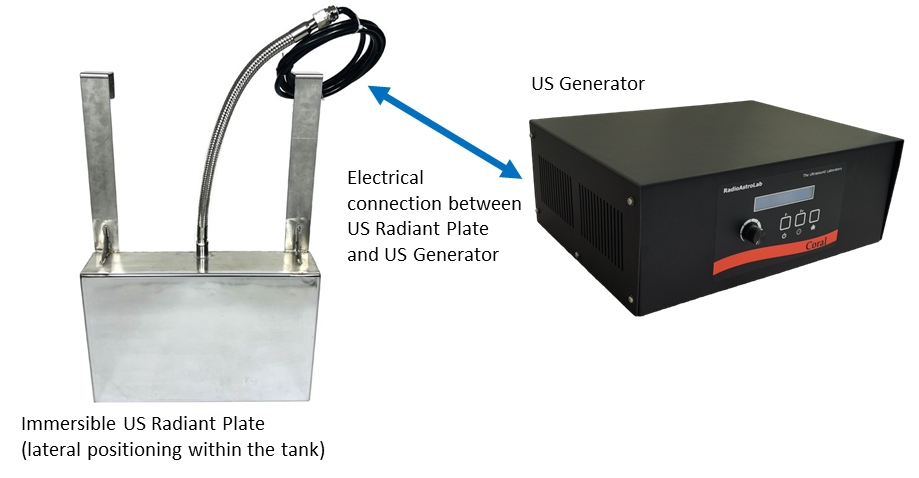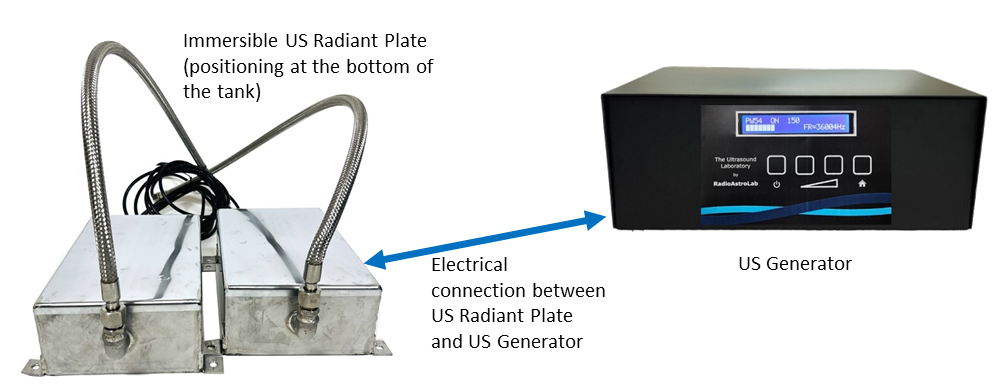MODULAR ULTRASONIC WASHING SYSTEMS

Our modular ultrasonic cleaning systems for industry and professional laboratories, combined with appropriate detergents, ensure perfect cleaning of immersed parts, removing any residual dirt. An optimal combination of ultrasonic generator parameters (power, frequency, and modulation), treatment time, and temperature deliver results otherwise impossible with traditional cleaning systems.
Submersible Radiant Plates for Industrial Ultrasonic Cleaning Systems
In a system with submersible radiant plates and independent US generators, the radiant plates are separate modules containing multiple piezoelectric transducers electrically connected in parallel, hermetically enclosed within a rectangular AISI 316 stainless steel enclosure. Each plate connects to an external ultrasonic generator and is immersed in pre-existing tanks. Equipped with suitable mechanical supports (almost always custom-made), a radiant plate can be positioned on the bottom, on the side walls, or suspended inside the tank.
Washing systems using radiant plates are flexible and scalable, especially when used in medium- and large-scale industrial plants: submersible radiant modules can be installed in existing tanks of various materials and sizes, are easy to replace or repair (as independent units), and are ideal for retrofitting projects when updating or expanding existing systems.
A system with radiant plates allows for optimized distribution of ultrasound radiation thanks to the flexibility and simplicity of positioning, chosen based on the type and quantity of parts being treated. Furthermore, multiple radiant plates can be used (a system that can also be expanded at a later date) to create a modular system that increases power, optimizes spatial coverage, and ensures treatment uniformity.
Flexibility: the ultrasonic power is adapted to the size of the load and the type of material to be treated, and multiple configurations can be implemented based on the type of product and the dirt to be removed. Existing tanks of any material can be used.
Reliability and simplified maintenance: if a module fails, it is easy to isolate and replace it without compromising the operation of the entire system.
Scalability: it starts with a basic setup that will be easily expandable or modifiable as production needs increase.
Efficiency, energy savings and functions customization due to the digital and programmable control of each module.
Below is an example of a modular system.

The simplest ultrasonic cleaning system with submersible radiant plates essentially consists of two distinct modules: the rectangular radiant plate (which includes an array of piezoelectric transducers) and an external ultrasonic generator that powers the radiant plate. Complex cleaning systems comprising multiple plates, each powered by its own ultrasonic generator, can easily be implemented, enhancing process flexibility, scalability, and reliability. This makes it easy to convert existing traditional cleaning systems (or parts thereof) into an efficient ultrasonic cleaning machine. The operating frequency of the radiant plate and the ultrasonic generator can be defined based on the application.
Each ultrasonic generator module is electrically connected to the mains supply voltage and to the corresponding radiant plate. When using multiple ultrasonic generators in a three-phase mains-powered system, load balancing must be performed in accordance with standard system criteria. All ultrasonic generator modules belonging to a system (single washing tank) will be connected to a control panel that manages the overall operation of the system. The final system will use a number of modules proportional to the total radiant power required, which in turn is proportional to the capacity of the tank.
Each ultrasonic treatment cell will be managed by a control unit comprising an electronic process board equipped with a display, operator panel, and a series of communication interfaces (RS485 serial port, Ethernet, WiFi, etc.) as needed. This control unit will be equipped with two data communication channels: the first is an internal bus connecting all the generators belonging to the same washing tank, and the second is a communication channel that allows connection to an external host device (such as a PLC or industrial PC) that manages the entire production line.
The best frequencies for industrial ultrasonic cleaning range from 19-25 kHz for treating very dirty, resistant mechanical objects (low frequencies generate intense cavitation, perfect for aggressive cleaning), up to 35-45 kHz for more delicate objects (optical items, jewelry, surgical instruments, etc.) that require thorough cleaning but with a more gentle cavitation effect. Obviously, there is no clear-cut, definitive boundary between these values: it is always advisable to experiment, case by case, to optimize the system parameters. Undoubtedly, the ability to continuously and accurately adjust the output power of our generators (from 20% to 100% of the maximum value), combined with programmable operating frequency, offers the best compromise in terms of versatility and safety in processing most materials.
It is always possible to implement a modular washing system where part of the US generators operates at low frequency to perform a “robust” initial treatment, aimed at removing stubborn dirt, while the other part operates at higher frequencies during the more delicate final phase of the process. It is also possible to program the system to operate simultaneously, according to pre-set cycles, at two different frequencies, possibly with different power levels.
When using a modular system built with independent programmable generators, numerous treatment customization options are available, managed from the control panel, sequencing the various operations with widely programmable power levels and cycle times to meet any requirement. Numerous features can be implemented, determined by the needs of the production process, management complexity, and, ultimately, cost. The great advantage of a modular system is the ability to develop and implement the various functions gradually, as testing progresses and market demands evolve.



